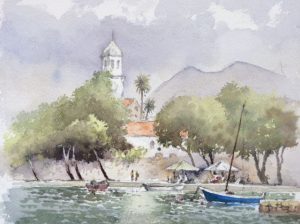I much appreciate the comments you make, and hope you are all keeping well and free from Covid-19. It’s certainly changing life at the moment, and surprisingly I’m managing to do more walking than normal, as I’m not travelling around with work. Getting out into nature is really the best thing we can do if possible, and May is a great time to be out on the hills with the sketchbook.
Another vital ingredient at times like this is a touch of humour to counter the appalling news coming through every day, and relieve any worries about where it will all end. Adding a little visual humour into your paintings, even in a small way can appeal to many folk. A while back I was sketching by a farm track when no less than three red tractors came along, driven by three rotund, red-faced farmers. I grabbed my camera and waved as they rattled past, then carried on sketching as they disappeared over the horizon. After several minutes they reappeared, coming the other way, and I managed to get some more shots of them.
I continued with my sketch, but then, back came the three tractors yet again, belching out fumes. This time they turned off at the junction where I stood and into the lane shown in the painting, which was my composition. Off past the farmhouse they roared and there was peace for a few minutes. Sure enough, shortly after they once again hove into view, still in perfect formation, coming back towards me, so I have included one of them in the painting. Unable to hold back my curiosity I stopped them as they approached to find out what they were up to. They were lost and were looking for a farm in the vicinity – probably for some agricultural soiree. I wasn’t familiar with the local area but I had a map and soon put them on the right course, and off they went.
What I hadn’t noticed during all the coming and going was that the lead tractor had a little passenger on one side, which you can see in this close-up detail. Watch out for this sort of thing as it can enliven your work. I could have made the tractor a bit more wonky and the farmer more of a cartoon character, and these are things worth considering before you touch the paper. When out and about I do like to engage with farmers and other folk as I often learn a lot and have more time to notice any little gems like this. It’s also worth carrying a few of your greetings cards with you to give away as you sketch someone’s farmhouse. They might well buy a painting off you! Mind how you go.






